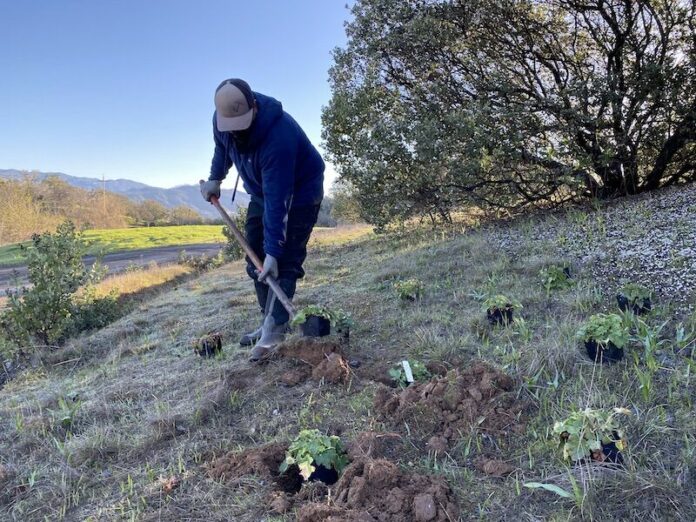
Earlier this spring, Jordan Vineyard & Winery announced the launch of a multi-year planting program to turn several acres of non-native grassland into a preserved habitat for pollinators such as the Western Monarch butterfly, natives bees and other insects.
Once completed, the sanctuary will be the largest dedicated pollinator habitat of all bee-friendly farming-certified vineyards nationwide, according to Pollinator Partnership.
The project on the 1,200-acre Jordan Estate in Alexander Valley will be located on the fall migratory route of the western monarch and will feature over 3,400 plants comprising about 100 species.
The pollinator-friendly plants will be planted across four initial sites totaling eight acres. The first plantings occurred in February and March, according to a press release from Jordan Vineyard & Winery.
Once all four sites are planted, the sanctuary should span 10 acres.
Lisa Mattson, the director of marketing and communications for Jordan Vineyard & Winery, said the plan to start a pollinator sanctuary stemmed from an introduction to Pollinator Partnership and a concern with the decline in the western monarch population.
“It was kind of a two part (situation). We discovered the Pollinator Partnership in San Francisco about three years ago and they contacted us because they heard about our vineyard and heard that we had 1,200 acres of land, 1,000 of which will always be wild, and they wanted us to collaborate with them on Pollinator Month,” Mattson said.
Pollinator Month is every June and aims to bring awareness to the importance of pollinators.
“We had summer hikes that year, and pollinators with that, mostly talking about our apiary because we had just started beekeeping at the time. We continued to stay in touch with them and then we heard about the western monarch butterfly annual migration population count numbers, which have made major headlines the last couple of years and so we saw that in 2019 and in 2020,” she said.
In 2019, Mattson started a conversation with winery CEO John Jordan, Brent Young, the director of agriculture operations and winery chef Todd Knoll about the dwindling monarch butterfly numbers.
According to The Xerces Society, in 2020 along the western coast the western monarch butterfly hit a low of only 1,914, a 99.9% decline since the 1980s.
“John said we should try to do something and so our chef and myself said we met the folks with Pollinator (Partnership) a couple of years ago and (said) let’s restart some conversations,” Mattson said.
The Pollinator Partnership director of operations visited the winery about a year ago to advise the Jordan team on what pollinator-friendly plantings they can have and where they could plant them.
Milkweed placed near water sources will be a key component of the garden for butterflies.
“For us it was also important to focus on native bees. We’re always focusing on doing work with honeybees and honeybees are wonderful, but we know as we have been working with bee hives for four years and learning more, we’ve also learned about mason bees and their importance and how prolific they are as pollinators,” Mattson said. “We have four different sanctuaries to start the program. There’s two for butterflies, one for native bees and a fourth for hummingbirds.”
About 600 pounds of milkweed plugs have already been planted, according to the press release. Two hundred pounds of wildflower seeds, including milkweed, were sown this winter and native grasses, annual and perennial wildflowers, scrubs and trees were integrated into the garden to provide year-round floral resources and nesting habitats for pollinators.
She said they also wanted to plant mason bee friendly plants to encourage the presence of other bee pollinators.
“Honeybees get most of the attention,” Knoll said in a statement. “But mason bees pollinate many of the fruits and vegetables we eat. They have a 95% pollination rate compared to honeybees at 5%.”
Mattson said in total, eight acres of the pollinator sanctuary has already been in the works.
“Right now, we’ve done eight acres, but we’ll be at 10 to 12 acres by the spring of 2023, so we’re just gradually adding more,” Mattson said.
Part of the reason to implement the plantings slowly is because of the high price of milkweed and the time needed for plants to sprout and grow. The Jordan team also has other duties to focus on.
Mattson called the project a labor of love.
“We’re all on this planet for a very short time and it’s everybody’s responsibility to try to make it a better place,” she said.
In a statement, Young said although the pollinators don’t have an impact on the grapevines, having a diverse pollinator sanctuary will help increase the biodiversity at Jordan Vineyards.
“The beauty of diversified agriculture is how far it spans in multiple directions in support of the overall ecosystem, from caring for cattle and honeybees and farming grapes to growing vegetables,” Young said. “Although these pollinators don’t have a direct impact on grapevines, creating more habitat for them is a natural extension of our approach to biodiversity at Jordan Estate.
In addition to the sanctuary, Jordan is also working with the Warm Springs 4-H club in Healdsburg on a milkweed germination project in an effort to grow up to 1,000 seedlings for planting this spring.








